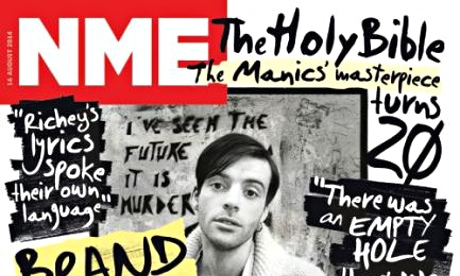
Britain's consumer magazines lost nearly 1m print sales in the first half of the year, according to the latest healthcheck for the industry.
As publishers continue to search for alternative revenue streams from the internet and digital products, the Audit Bureau of Circulations said on Thursday sales of the hundreds of paid-for weekly and monthly titles fell 4.4% compared with the previous six months.
Even venerable titles such as the 62-year-old New Musical Express were far from immune, its weekly circulation falling to 14,000, down 28% from a year ago.
Following the closure of lads' title Nuts earlier this year, and the announcement on the eve of the latest ABC report that women's glossy Company is going web only after 36 years, a new wave of closures now beckons for titles struggling to survive on dwindling sales.
Magazine publishers, like newspaper owners and broadcasters, have been dealing with the disruption wrought on their business models by the internet for the best part of a decade.
Total sales of all magazines came in at 21.2m copies, a sharp contrast to sales of digital editions – usually a replica of the print magazine for the iPad and other tablets – that were just 396,000.
However, NME publisher IPC Media pointed out its reach across all platforms, print and digital, including its website, reached 3.6 million, making the brand "bigger than it has ever been" as the title's print sale peaked at more than 300,000. Traffic on the NME mobile website grew 85% year on year, with nearly 40% of its total online audience now reading on mobile.
All five titles in the paid-for music magazine sector, including Q, Kerrang! and Mojo, reported double digit sales losses in circulation the first half of 2014. "Certain genres are struggling," said Douglas McCabe, a media industry analyst at Enders. "There are a number of titles where physical sales are falling to a level that makes the business look quite difficult, NME would be very good example. Music discovery has moved online."
There are almost 500 paid-for and free consumer magazines officially audited by ABC, 114 with a circulation of 20,000 or fewer copies.
Men's magazines continued to take a battering, with Bauer's FHM down almost 22% to just over 83,000 print sales, while weekly Zoo failed to benefit from the closure of Nuts, with sales down 22% year-on-year to just under 28,000.
Richard Desmond's trio of celebrity and gossip titles – OK!, New and Star – all suffered significant double digit declines.
"There is a two-tier market in consumer magazines where there are very clear winners and losers," said McCabe. "There tends to be a few stable titles, like, say a Vogue, but further down each sector there are those feeling the pressure because the market is oversupplied."
Publishers initially had high hopes for digital tablet versions of their magazines following the launch of Apple's iPad in 2010, particularly given the visual and graphic possibilities of the format. However, that has given way to a more sober assessment.
There is some promise with the growth in digital edition sales leaping 26% year-on-year – more than 40% of UK consumer magazines now have one. However, even the giants of the print world report just a few thousand sales at most.
Kerin O'Connor, the chief executive of Dennis Publishing's weekly news digest title the Week, said a tablet edition was just a part of the path to sustainable profitability.
"When the iPad launched most publishers thought about tablets but that only really worked for about a year and a half. Now it is all about the phone. In two years it could be something else. Our strategy is publish once, publish everywhere."
News and current affairs titles generally proved one of the more resilient magazine sectors. The Week increased its print sales by 1.1% to almost 200,000, with digital sales at 26,283, a relatively impressive 13% of the total. The Week charges £90 for a digital subscription, launched three years ago, and a £120 for a bundle with the print product.
"I'd rather have 26,000 people who pay me for it than 260,000 who visit a site and pay nothing," O'Connor said.
The Economist's UK edition lost 3.5% of print sales, but digital sales grew 72% to 21,780.When print and digital sales are combined, the Economist overtook Private Eye to become the top selling UK news and current affairs title with an average combined circulation of 223,730.
However, only 70% of the Economist's print circulation was paid for, its headline figure including 57,681 copies that were given away for free.
Private Eye remains a strong performer in print with an average circulation of 218,290, down 2.1% year-on-year, although it has only a rudimentary web presence.
"If you look at titles doing well in print and digital it is generally the ones with a high subscriber base or loyal readership, business titles like the Week and Economist and some of the food titles, that are doing really well," said Zoe Bale, head of press at media buying agency Carat. "The reason the magazine sector struggles a little bit is that it is a fickle marketplace. There is much less [brand] loyalty than in say radio or newspapers. All publishers are looking to diversify, they are experts in content, so there is still huge opportunity."

